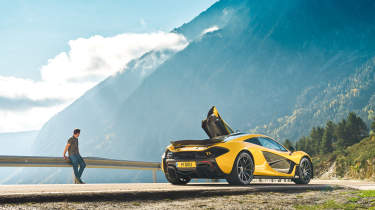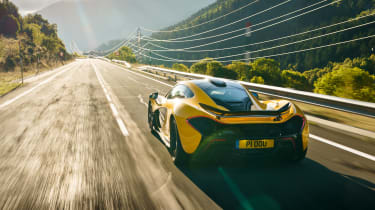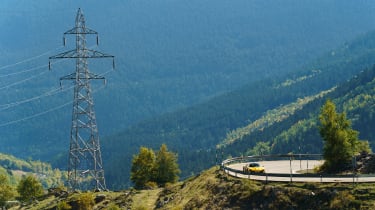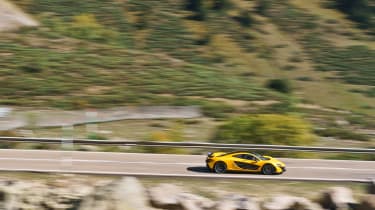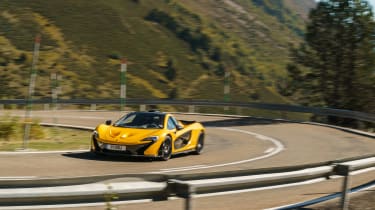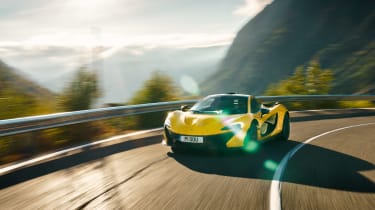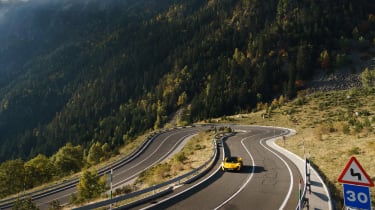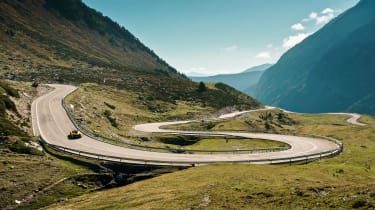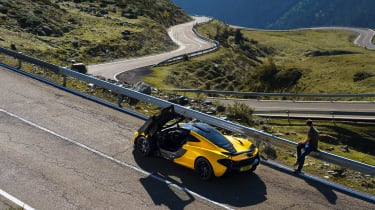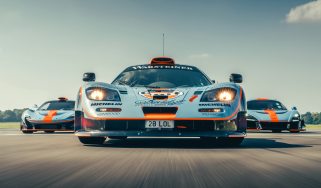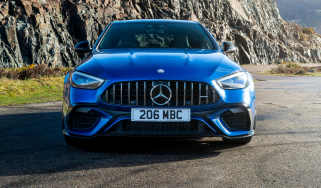Dream drive: McLaren P1 in the Pyrenees
In 2013, the McLaren P1 mesmerised with its otherworldly capabilities. Nine years on, has time and progress diluted its shine? We find out on the twisting roads of the Pyrenees
'Nine hundred and three.’ I’ve lost count of the number of times I’ve said it in the past 24 hours. There will be dozens more in the next couple of days. But for some reason right now, at a tiny Repsol station in La Molina, it dawns on me just how outrageous the McLaren P1 remains. The station is one of those strange petrol station/café/workshop/community centre/off licences you only get in small-town Spain. When I arrived there were two people sitting outside, smoking and drinking coffee. Or maybe something stronger. Now – less than five minutes later – there must be 15 or 20 and nearly as many scooters and beaten-up SEATs crammed into the forecourt. ‘How much horsepower?’ somebody asks. ‘Nine hundred and three.’ His eyes almost pop out of his skull before his friend repeats it back, shaking his head, laughing and pointing his phone at the P1 with its door raised to the sky. I’m standing next to him doing exactly the same.
The run down from the peak of Puigllançada, in north-eastern Spain, had been slow and easy, the P1 on fumes and the last dregs of battery power and its driver pretty much spent, too. But the run up the preceding spectacular ridge demonstrated what 903bhp was all about. A frantic few minutes that crystallised why we came all the way to Spain in the first place with little more than a rough plan to drive from Barcelona on the north-eastern coast all the way to Bilbao, close to the Bay of Biscay. A haphazard road trip taking in the best roads of the blissfully empty Pyrenees to investigate whether McLaren’s first Ultimate Series car still feels as insanely potent and laser precise as it did back in 2013. To chart the trajectory of the supercar and hypercar and ponder what’s left behind when similar performance is now available in a car as ‘normal’ as the 992 Turbo. Annoyingly, we’re only two hours into our journey and I’m pretty much sold on the P1. In short, it is completely and utterly unhinged.
> McLaren P1 – review, history, prices and specs
Of course, the raw numbers – 903bhp, 664lb ft, 1490kg – say that it has to be… but casting my mind back to 2013 and all the hype surrounding the ‘Holy Trinity’ (wow, that sounds cringeworthy now, doesn’t it?), the real excitement around the P1 centred on its track performance and unprecedented downforce in Race mode. You know the script: Select Race and the P1 drops 50mm and the spring rate increases by 300 per cent. Simultaneously the hydraulics do their shapeshifting magic, rear wing extending 300mm and adjusting its angle for maximum downforce.
Thus configured, McLaren claimed 600kg of load at 161mph, at which point the P1 starts trimming its aero devices to ‘spill’ downforce away so as not to overload the suspension. How cool does that sound? It seemed almost by the by that the P1 would hit 217mph and do 0-62mph in 2.8sec and 0-124mph in 6.8sec. Your £866,000 really bought you a whole heap of tech and aero harnessed to deliver incredible track performance. The three new hypercars each had its own distinct personality. The 918 Spyder was stunningly well resolved, the LaFerrari used hybrid technology to elevate the V12’s intensity to a new plane, and the P1 was all about celebrating McLaren’s motorsport pedigree. We had them all worked out.
Only maybe we didn’t. Whilst the petrol station crowd continues to take selfies, all I can think about is how crazed and industrial the P1 felt back on that amazing climb. Laser-guided? Only if the beam fires out as thick as a tree trunk from a gnarly old pump-action shotgun and the kickback nearly rips your shoulder from its socket. As supercar owners seem to be so fond of wraps, I’d suggest a Millennium Falcon theme would suit the P1 nicely. It’s a spaceship hot-rod.
Of course, Race mode is only for the track, and aero at 161mph doesn’t count for much on a mountain pass anyway. On these roads you simply have the grip of two 315-section rear tyres to channel the 3.8-litre twin-turbocharged V8’s 727bhp and 531lb ft plus the electric motor’s instantly available power. To call it a busy, almost bruising experience is an understatement. The P1 feels at once constrained and so powerful that it’s running out of your control. A cacophony of turbo shrieks, sci-fi electric motor sounds, rapidly blurring numbers on the digital display and the sound of those tyres being assaulted. Nine hundred and three. The shock of it isn’t diminished one bit.
It’s pitch-black when we roll out of La Molina and continue to head west, now on the N-260. This is Spain’s answer to the Route Napoléon. Seemingly endless, ever changing and punctuated by beautiful little towns, sudden steep climbs and flat, perfectly sighted sections that run along the valley floor. It can be busy in peak season but tonight there’s just the occasional camper van or wheezy old farm truck. It is bliss.
Even so, the P1 is running at less than half pace. Instead I’m exploring a side to the car that wasn’t really possible in the launch phase, so keen were we to experience it at full noise on track. Now, with RaceActive Chassis Control (maybe McLaren led us down a path…) dialled back to fast road settings, new sensations, noises and quirks come to the fore.
The driving environment is fantastic. I adore the beautifully sculpted seats that are reclined just so, the simple Alcantara-trimmed steering wheel with two cool metallic buttons denoting DRS in blue on the left spoke and IPAS (Instant Power Assist System) in red on the right. Chances of using these buttons more than once? Probably zero. I wouldn’t change them for the world. More than anything the P1 feels – and I’m not sure McLaren would like this description – like a prototype. Pared-back, slightly flimsy in places and with the innate cool of a disguised development car fresh from some laps at the Ring. At night you get the added bonus of the cabin bursting blue and yellow as you play with throttle and gearbox for maximum flame-spitting.
Then there’s the noise. The P1 appears to have no sound deadening whatsoever and everything is competing for your attention. The tyres hum and whoosh, the engine has the familiar McLaren flat-plane-crank howl but it seems to rip more easily through the car, and the percussive twin-turbo set-up is so loud it seems to suck the air from your lungs. Grit and gravel flicks up and pings beneath you, the electric motor whines and then winds up when you crack the throttle at low revs as it attempts to fill the holes left by a turbocharged engine pushing 191bhp per litre. The whole car is alive. Turns out that going slowly in the P1 is a very fine thing to do.
The next day is a day to go a little faster. We’ll veer off the N-260 onto the C-28, which cuts through the Gerber Valley and climbs to Baqueira-Beret ski resort, then push on as far west as possible. The approach to the criss-crossing gondola lines is like all your mountain pass fantasies rolled into one and so much better than many of the famous climbs in the Alps. Hairpins are wide and smooth, the surface miraculously good despite the snow and freezing temperatures of winter, and the scale of the road allows even a P1 to dig deep into its reserves of power and grip. The weather is perfect. Maybe evo should relocate to Spain.
Mood and confidence are high so I do the unthinkable in a car of such monumental performance. I turn off the ESC. I’d love to talk you through the process but I can’t remember how you do it. Press and hold the Aero and Boost buttons mounted within the toggle switches for Powertrain and Chassis controls? Then release and confirm by repeating? Maybe. Sounds about right. I think my brain has blocked it out as it’s the last hangover of the old ‘we know better’ McLaren philosophy that was all over the uptight, prescriptive and sometimes shoddy MP4-12C. Thankfully these days there’s a button marked ‘ESC’. Who knew that would be a good idea?
As the road starts to compress in on itself I know this could be another magic moment. I’ve become familiar with the brutal performance and so the shock, hopefully, won’t be as great and I can concentrate on the detail rather than becoming swept up by the experience and dumped out the other side like a great wave has crashed over me. The road is smooth enough to take the stiffest road-going set-up (confusingly called Track) and the Powertrain toggle is dialled around to T. I’m on high alert. The P1 is not a car that allows you to decimate a road without serious concentration and an amount of mental recalibration. Let’s just say you arrive at corners travelling very, very quickly.
Despite the weight of the electric motor and batteries the P1 feels light and nimble. It actually gets upset quite easily on the fast approach to the hairpin section, front and rear struggling to deal with ridges as one and the wheels and body sometimes taking a breath or two where they’re not fully aligned. This momentary disconnect is exaggerated if going from throttle to brake as the whole car seems to float a length or so before the brakes pluck the body back onto its springs and start to shed speed. The Akebono brakes remain powerful and consistent, but the pedal is nowhere near as reassuring as, say, the Senna’s, and you feel the relatively narrow contact patch at the front is a limiting factor.
A fast left leads into a long 90-degree right. The P1’s steering is light and full of that delicious fingertip feel so intrinsic to the McLaren experience, but the rack feels slower than I thought it would and the front doesn’t respond quite as I’m expecting. A 720S would have dived to the apex but the P1 is gently pushing wide and the torque-fill of that electric motor is effective but not a complete solution. More throttle feeds the understeer and then, all of a sudden, the turbos hit boost and the brake-steer system frantically tries to equalise torque across the rear axle. Ultimately there’s simply too much of it and the Pirellis are soon spinning up and you’re sliding a car with 903bhp. Weirdly, the P1 never feels more secure and natural than when exiting a corner with some angle on and a trail of wispy smoke hanging behind it. The Senna has moved the game on for control and grip, but it doesn’t indulge with the P1’s good humour. Not even close.
The engine really is mighty once you start to use all of the available revs, and the seven-speed dual-clutch ’box, whilst not as savagely quick as the best Ferrari offering nor as magically precise as the latest PDK, is exciting to use because every upshift seems to grant access to even more power. It’s an illusion of course, but the fact the P1 pulls just as hard in fifth as in second or third leaves you in no doubt that you’re strapped into something with performance you could never grow fully used to exploiting. The chassis copes, just. And it needs plenty of help from the driver.
In quicker corners the P1’s balance shifts. Suddenly the front end is nailed down and it’s the rear struggling to keep up. More than once I roll into a turn at the top end of third and sense the tail starting to come around sharply. It’s a wicked surprise and sends a flush of heat down my neck. This thing is serious. I’d love to say I learnt to trust the car and use the pointiness to glide it through quicker turns with minimal steering lock, but I’d be lying. Sliding a P1 out of slower turns is one thing, letting it dance on the edge at high speed is something else and best left to the racetrack. Even so, it’s a trait that befits this car’s wild character. Remember when Formula 1 switched to the new hybrid era and for just a couple of races the drivers and teams couldn’t get to grips with the cars? The raw energy contained within was tangible, almost spilling over. That’s the P1. I can’t think of another supercar that feels quite so untamed.
It should be exhausting. And a P1 driven anywhere close to its potential for an extended period would be. Yet when we pass through Baqueira and head on to Vielha I’m not at all phased that we’ve still got over five hours of solid driving ahead before hitting Bilbao. Much of it is on the N-260 and the P1 can carry good speed without breaking sweat. I know there will be moments where I can’t resist feeling the crazed hit of acceleration, maybe scattered bursts of manic thrills when the road empties and it’s impossible to not lean on the chassis and test the brakes, but I also know that a P1 simply covering ground is a fascinating, charismatic monster of a car. It really is an enthralling thing to spend time with.
The P1 has its faults and its outright speed around a circuit or along a road through the Pyrenees has been eclipsed thanks to McLaren’s own rampant development cycle. Others, too, have caught and surpassed the once untouchable hybrid hypercars. Maybe the new 992 Turbo, a car you could happily use every day, would defy the numbers and eat up the P1 thanks to its combination of devastating grip, linear power and predictable four-wheel-drive chassis. But we came to Spain to discover what’s left when a car defined as an ultimate is no longer the fastest, the strongest, the best. The answer is complex and nuanced, and in the case of the P1 it’s that you can focus on the car’s true character and discover what it can do away from the massive expectations created by unprecedented hype. In other words, it’s far from the end of the story. Of course, if you’re feeling lazy, there’s a simpler answer to what makes the P1 so special. Nine hundred and three. Seems to do the trick.
McLaren P1 specs
| Engine | V8, 3799cc, twin-turbo, plus 131kW electric motor |
| Power | 903bhp (combined) @ 7500rpm |
| Torque | 664lb ft (combined) @ 4000rpm |
| Weight | 1490kg |
| Power-to-weight | 616bhp/ton |
| 0-62mph | 2.8sec |
| Top speed | 217mph (limited) |
| Price new | £866,000 (2013) |
| Value today | £1.1m-1.35m |
This feature was first published in evo issue 276. Browse back issues here.

